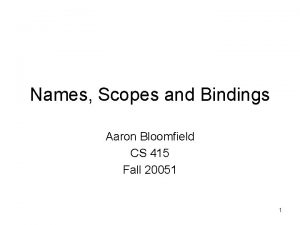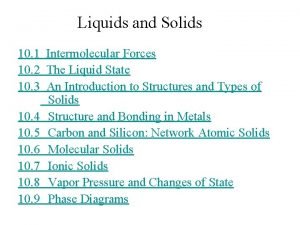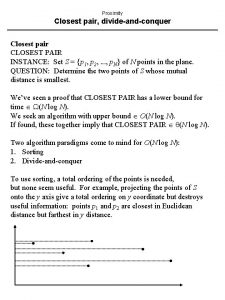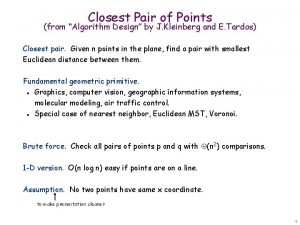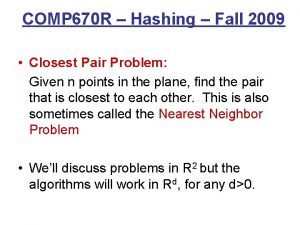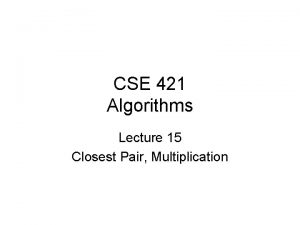Closest Pair Given a set S p 1











- Slides: 11

Closest Pair Given a set S = {p 1, p 2, . . . , pn} of n points in the plane find the two points of S whose distance is the smallest.

Closest Pair – Naïve Algorithm Pseudo code for each pt i S for each pt j S and i<>j { compute distance of i, j if distance of i, j < min_dist = distance i, j } return min_dist n n Time Complexity– O(n 2) Can we do better?

Closest Pair – Divide & Conquer n Divide the problem into two equal-sized sub problems n Solve those sub problems recursively n Merge the sub problem solutions into an overall solution

Closest Pair – Divide & Conquer n Assume that we have solutions for sub problems S 1, S 2. n How can we merge in a time-efficient way? n n n The closest pair can consist of one point from S 1 and another from S 2 Testing all posibilities requires: O(n/2) · O(n/2) O(n 2) Not good enough

Closest Pair – Divide & Conquer dimension d = 1 n n n Partition S, a set of points on a line, into two sets S 1 and S 2 at some point m such that for every point p S 1 and q S 2 , p < q. Solve Closest Pair recursively on S 1 and S 2 Let 1 be the smallest distance in S 1 and 2 in S 2 Let be the smallest distance found so far: = min ( 1, 2) What is the closest pair in S? n Either {p 1, p 2} or {q 1, q 2} or some {p 3, q 3} with p 3 S 1 and q 3 S 2. S 1 p 2 S 2 p 3 q 3 m q 1 q 2

Closest Pair – Divide & Conquer dimension d = 1 n To find a pair {p 3, q 3}, Is it necessary to check all possible pairs? n n How many points of S 1 or S 2 can lie within of m? n n n No Since is the distance between the closest pair in either S 1 or S 2, there can only be at most 1 point in each side. Therefore, the number of distance computations required to check for a closest pair {p 3, q 3} with p 3 S 1 and q 3 S 2 is O(1). Thus, the time complexity is n O(n log n) S 1 p 2 p 3 q 3 m S 2 q 1 q 2

Closest Pair – Divide & Conquer dimension d = 2 n n n Partition two dimensional set S into subsets S 1 and S 2 by a vertical line l at the median x coordinate of S. Solve the problem recursively on S 1 and S 2. Let {p 1, p 2} be the closest pair in S 1 and {q 1, q 2} in S 2. Let 1 = distance(p 1, p 2) and 2 = distance(q 1, q 2) Let = min( 1, 2) S 1 l S 2 p 1 1 p 2 q 1 q 2 2

Closest Pair – Divide & Conquer dimension d = 2 n n n In order to merge we have to determine if exists a pair of points {p, q} where p S 1, q S 2 and distance(p, q) < . If so, p and q must both be within of l. Let P 1 and P 2 be vertical regions of the plane of width on either side of l. If {p, q} exists, p must be within P 1 and q within P 2. For d = 1, there was at most one candidate point for p and one for q. For d = 2, every point in S 1 and S 2 may be a candidate, as long as each is within of l, which implies: O(n/2) = O(n 2) Can we do better ? P 1 l P 2 p 1 S 1 1 q 1 S 2 p 2 2 q 2

Closest Pair – Divide & Conquer dimension d = 2 n n n For a point p in P 1, which portion of P 2 should be checked? We only need to check the points that are within of p. Thus we can limit the portion of P 2. The points to consider for a point p must lie within 2 rectangle R. At most, how many points are there in rectangle R? P 1 S 1 p l P 2 S 2

Closest Pair – Divide & Conquer dimension d = 2 How many points are there in rectangle R? n Since no two points can be closer than , there can only be at most 6 points n Therefore, 6 O(n/2) O(n) n P 1 P 2 S 1 Thus, the time complexity is n l O(n log n) How do we know which 6 points to check? S 2 p R

Closest Pair – Divide & Conquer dimension d = 2 How do we know which 6 points to check? n Project p and all the points of S 2 within P 2 onto l. n Only the points within of p in the y projection need to be considered (max of 6 points). n After sorting the points on y coordinate we can find the points by scanning the sorted lists. Points are sorted by y coordinates only once. n To prevent resorting in O(n log n) in each merge, two previously sorted lists are merged in O(n). Time Complexity: O(n log n)
 Total set awareness set consideration set
Total set awareness set consideration set Training set validation set test set
Training set validation set test set Unordered set of pairs
Unordered set of pairs Rolling pair is higher pair
Rolling pair is higher pair The closest algal relatives of land plants are
The closest algal relatives of land plants are Closest airport to silver spring md
Closest airport to silver spring md What is thermosphere
What is thermosphere Cpa closest point of approach
Cpa closest point of approach Closest nested scope rule
Closest nested scope rule Closest kohls
Closest kohls Dipole-dipole attractions
Dipole-dipole attractions Closest african country to europe
Closest african country to europe








